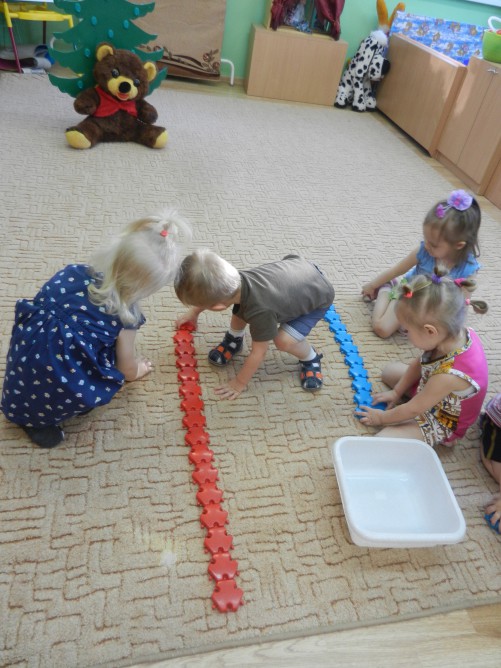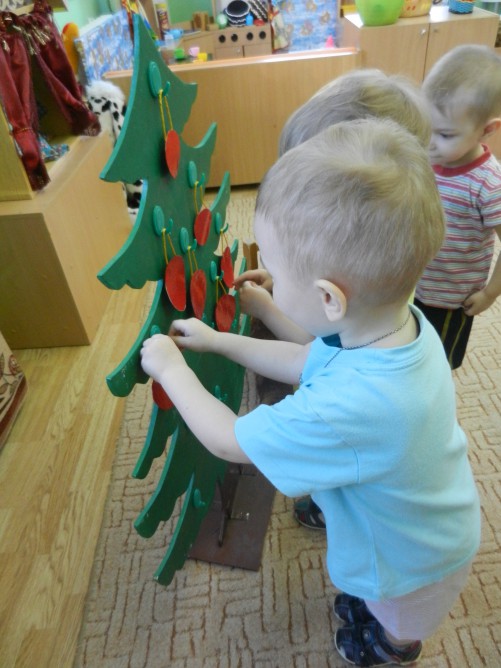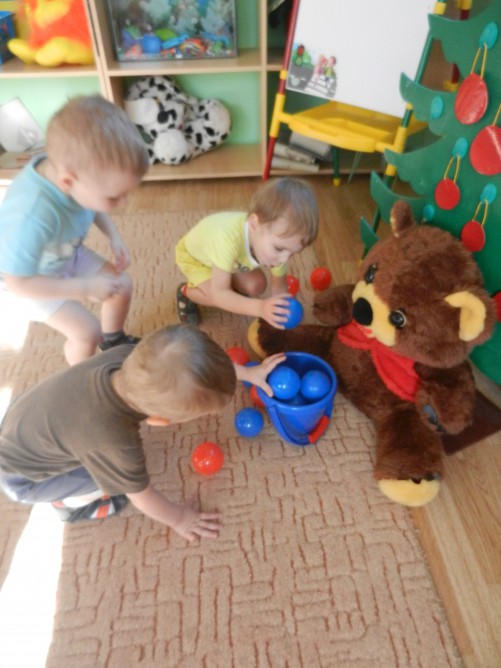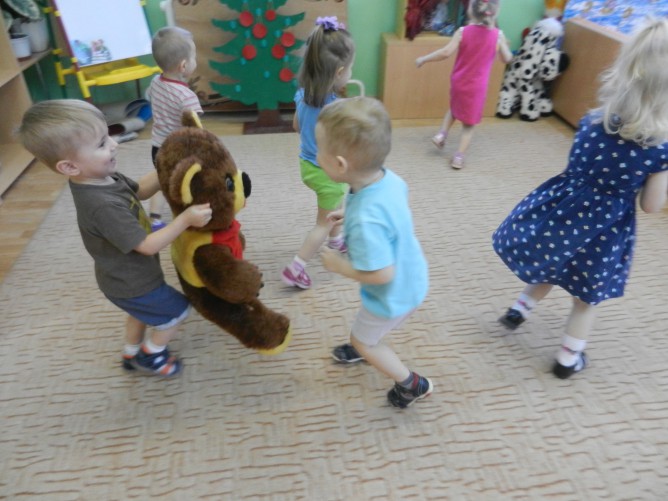Galina Shablovskaya
Organized educational activities on sensory with children of the 2nd group early age"DEWDROP".
SUBJECT:"Visiting the Bear"
Tasks:
Cognitive development: To consolidate the ability of children to group and correlate objects by color and name it.
To consolidate the ability to recognize objects by size and call the word: big and small.
Our flagship product is the leading and most complete digital resource early learning for children aged 2 years. Through student management, professional development, curriculum alignment, and progress reporting, we help ensure student success in every grade. Uniquely, these products also offer home access versions that are designed specifically to engage children in learning outside the classroom while strengthening connectivity to the school home, which has been shown to improve learning outcomes.
Developing: Develop fine motor skills.
Social and communicative development: Encourage children to play together. To evoke an emotional response in children and a desire to participate in a game situation.
Speech development: the formation of a culture of communication (to say hello to the bear, to thank for the treat and to say goodbye, to fix the words (ball, round, big and small). Help children answer questions: what is it? What? Learn to repeat simple phrases.
A team of teachers evaluate each product in the classroom for quality, learning value, ease of use, and innovation. Teachers' Choice is the only awards program that is solely judged by teachers in the classroom. I loved so much this product. This is a product that is very adaptable to most all students. I love that this product allows kids to use technology in a fun yet academic way. Kids learn new skills while playing!
I love everything about this product. Probably my favorite feature of the site is the fact that there is life beyond letters and numbers. In general, I really like this site and how it is set up. The lessons were age appropriate and fun for everyone.
Preliminary work: - Didactic game"Find the figures by color" - Floor mosaics (4 primary colors) - The game "Big and small balls"
Equipment: Big soft toy bear; Christmas tree; box with a large mosaic of red and of blue color; a bucket with red circles in two sizes; two buckets of red and blue with small balls.
Using an outstanding panel of educators, academics, librarians and parents, Parents' Choice Foundation identifies the best products for children of all ages, backgrounds and skills and awards those products with its Parents Award.
Only 20 percent of all applications receive a reward. This site took me by surprise. However, when entering the site, the number educational materials, the organization of classroom levels, the ease of navigation and help features available, and the wide depth of activities available are almost overwhelming.
Course progress. Children play in a group. Knock on the door (I draw the attention of the children). I go to the door, open it and take the bear with the box. I'm adding a bear to the group.
Bear: Hello kids! Will bring up: Children, let's say hello to the bear. Children: Hello bear! Bear: I'm bored alone in the forest, and I came to you in Kindergarten. Will bring up: Guys, the bear wants to tell me something (I put the bear to my ear). He invites us to his forest. And to go to the forest, you need to build paths. Look what the bear brought us. What is it? Children: Mosaic. Will bring up: What color is the mosaic? (I ask several children.) Children: Red. Blue. Will bring up: Guys, the bear asks you to build paths. One lane - red and the other is blue. (Children build, and the bear looks and praises the children).
Editor's Choice Award - Technology Review for Kids
Jessica Hensley, reviewer for Parents' Choice. The purpose of the Children's Technology Review is to "de-mystify" the latest technology products and services for parents and teachers through comprehensive, objective, child-centered reviews. The review process is designed to measure five factors that are commonly applied to most interactive media for children: ease of use, educational value, entertainment value, design features, and overall value.

Will bring up: Guys, and the bear asks what color did you build the tracks? Rodion, show me which path is blue. And Margarita will tell the bear what color this path is? (Children call and show, and the bear praises.)
Will bring up: Guys, let's go with the bear along the paths forward. And there is a forest in which the bear lives. We approach the tree. Will bring up: And the bear again says something in my ear. Mishka is sad for some reason. He wanted to decorate the Christmas tree and couldn't. Let's help him. The bear gives a bucket with red circles on strings and asks to hang them on the Christmas tree.
A panel of judges, which includes education and media experts, parents, librarians, academics, and medical and business professionals, evaluate products and services on product quality, design, educational value, entertainment value, attractiveness, value, and other elements. This product takes almost every aspect of preschool and kindergarten and puts it into an interactive website that a child can do on their own. He will now enter kindergarten already knowing these computer skills.

Will bring up: Tell me, what is this bear in a bucket? Children: Circles Will bring up: Danya, what color are the circles? (red). Will bring up: Lyosha, tell us, what are the largest circles? (We are considering.) Lesha: Big and small. Will bring up: The bear asks to take large circles (Children take). Will bring up: Tanya, tell me which circle did you take? (red, large). And what circle did Rodion take? (big and red).
National Parent Center - Seal of Approval Winner
Teacher Award Instructor. The mission of the National Center for Parenting is to advise, support and guide parents with advice from world-renowned experts in the field of parenting and child development. In the colorful classroom, children will find games and activities that teach reading, math, science, colors and music. The games use songs, puzzles and books that are read aloud to your child.
Users get a good level of immersion with the right dose of rewards built in. Lots of educational content and easy to use and learn. Awards are given the best products based on these group play tests. The depth and breadth of this online curriculum for kids ages 2-6 is truly amazing. The material is organized and presented in such a way that it is very attractive and easy to navigate. The lightweight interface allows for smooth sailing while providing essential learning foundations for reading, math, science, social studies, art and music.
Bring up: And what circles did the bear have? Children: Small, red.
Will bring up: Let's hang big circles on the Christmas tree. Children, how we decorated the Christmas tree beautifully. Margarita, the bear asks what color you hung the circle? margarita: red circle. (bear praises children)
The bear thanks the children. We all clap our hands together.
And parents set the level at which children learn - from preschool through kindergarten. The purpose of the awards is to provide parents with all the information they need to make informed decisions about their children. These songs also help children develop vocabulary and introduce them to music at an early age.
Teaching Quality Standard and Family Standard of Excellence
Sites are designed for design, interactivity, technology, content, innovation, copywriting, and ease of use for the target audience. In many countries, child labor is mainly an agricultural problem. Globally, 60 percent of all children working aged 5-17 work in agriculture, including farming, fishing, aquaculture, forestry and livestock. This amounts to over 98 million girls and boys. Most child laborers are unpaid family members.

Bring up:
Guys, Mishka accidentally dropped a bucket of balls and asks to help him collect it. Let's help. The bear said that collect the blue balls in the blue bucket, and in red - red. (children collect).

Will bring up: Dasha, what balls did you collect? Dasha: Blue. Will bring up: And what balls did Igor help the bear collect? (blue)
In agriculture, this percentage is higher and is combined with very early entry into work, sometimes from 5 to 7 years. Agriculture is one of the three most dangerous sectors in terms of work-related deaths, fatal accidents and occupational diseases. About 59 percent of all children in hazardous work aged 5-17 are in agriculture.
Poverty is the main cause of child labor in agriculture, as well as limited access to quality education, inadequate agricultural technology and access to adult labor, high hazards and risks, and traditional attitudes towards the participation of children in agricultural activities. Particularly in the context of family farming, small-scale fishing and livestock production, some involvement of children in non-hazardous activities can be positive as it contributes to intergenerational transfer of knowledge and food security for children.
Will bring up: Margarita, what kind of balls did you collect? (red). Will bring up: Guys, we helped the bear, and now let's invite the bear to play with us the game "At the bear in the forest" (children call the bear to play).
The game "At the bear in the forest"

Will bring up: The bear thanks you for playing with him, helping to decorate the Christmas tree, collecting balls, and tells you: “Thank you.” For this, he wants to treat you (the bear offers cookies to the children)
It is important to distinguish between light duties that do not harm the child and child labour, which is work that interferes with compulsory education and is detrimental to health and personal development, based on the hours and conditions of work, the age of the child, the activities performed, and the associated hazards.
Participation in some agricultural activities is not always child labor. Age-related tasks that are less risky and do not interfere with children's learning and leisure activities may be a normal part of growing up in a rural environment. Particularly in the context of family farming, small-scale fishing and livestock production, some participation of children in non-hazardous activities can be positive as it contributes to the transfer of social and social skills between generations and food security for children.

Will bring up: What should you say to the mouse? Children: Thank you! Will bring up: Guys, it's time for us to join the group, let's say goodbye to the bear. Children: Goodbye, bear.
Educator: Shablovskaya Galina Nikolaevna.
21. Features of conducting educational situations with young children.
Increased self-confidence, feeling dignity and work skills are attributes that are often found in young people involved in some aspect of farm work. Therefore, it is important to distinguish between light duties that do not harm the child and child labor, which is work that interferes with compulsory education and is detrimental to health and personal development based on the hours and conditions of work, the age of the child, the activities performed, and the hazards involved.
Child labor is prevalent in all sub-sectors of agriculture, although it has different characteristics. Progress in eliminating child labor in agriculture has been slow due to the nature of the sector. Limited coverage of agriculture and family obligations in national labor laws, limited trade unionism, labor force fragmentation, low capacity of labor inspectors to reach remote rural areas, most child workers working as unpaid family labor without formal contracts, continuity between rural households and in the workplace and the traditions of children involved in agricultural activities from an early age make it difficult to solve the problem.
Working with young children requires a special approach. Classes with young children differ from classes with preschoolers not only in the volume and content of the material, but also in the specific methods of conducting classes. Lessons can be done individually or in a small group. The teacher should sit at the same table with the children in order to be able to help each child.
Gender roles, age and cultural norms differentiate between the type of work girls and boys work, the number of hours worked, and who receives an education. Gender differences in child labor increase with age. Questions covering all sub-sectors of agriculture.
International partnership in agriculture
It was launched to promote the participation of agricultural organizations in global efforts to eliminate child labor in agriculture. Poverty and inadequate enforcement of labor laws are among the causes of child labor in agriculture, but the hazardous nature of agricultural work and the structure of agricultural production must also be taken into account in order to eradicate this practice. Stakeholders in the agricultural sector can play an important role in this direction.
In order to build the work in the best way, the educator must also have a good idea of the psychological characteristics of the early age: the features of the development of perception, attention and memory, speech, thinking, activity, etc.
So, when working with young children, the following points should be considered:
A child learns the world with the help of an adult by imitation
Advocacy and outreach efforts have contributed to a better understanding of this issue and the need for agricultural and labor professionals to join forces, knowledge and experience in the elimination of child labour. The partnership also carries out capacity building activities at the country level to support key actors in the agriculture sector to address child labor issues in national policies and programmes, extension services and monitoring activities.
Toddlers explore with interest the sensory properties of surrounding objects, open and close, throw, touch, sniff, taste. But only with the help of an adult, the child learns the functional purpose of our household items - that they eat soup with a spoon, and dig sand with a spatula, read a book, and draw with a pencil.
An adult introduces the baby to new games when he teaches him to lull a doll, build from blocks, roll a car by a string, etc. Watching an adult and repeating his movements, actions, words, the child learns new skills, learns to speak, serve himself, becomes more independent.
The partnership works at the national, regional and global levels to. To link the problems of child labor in the programming of the activities of agricultural and labor organizations. Promote the adoption of safer farming practices and prevent children from undertaking hazardous farm work. Improving rural livelihoods and income-generating activities.
- Strengthen employment opportunities for youth in agriculture.
- The last edition of the course took place in May.
- For more information about upcoming releases, visit the website.
Conclusion: classes with kids are based on imitation of an adult, his movements, actions and words, and not on explanation, conversation, suggestion.
In the joint activity of a child and an adult, it is necessary to combine elements of play and learning.
Young children are active, mobile and inquisitive. Children's spontaneity underlies the knowledge of the world around us and communication with people. Babies have not yet formed concepts: what is good and what is bad, how you can behave and how you can’t, etc. Education for kids is possible only when the positive emotions of the child are affected. Such an emotional upsurge can only be achieved in the game. A conscious attitude to learning will appear later - in the senior preschool age. In the meantime ... if the baby is not interested, he will simply turn away or leave.
Conclusion: learning elements must be introduced into specially organized games.
Repetition is required for a new skill to stick.
Toddlers love to repeat the same action (or movement, word, etc.) over and over again. This is a learning mechanism: a skill needs a lot of repetitions to become established, and the more difficult the skill, the more time and number of repetitions it will take.
The assumption that a child's play and activities need to be constantly varied is correct for older children. And kids feel more comfortable in a familiar situation, act more confidently in the course of familiar favorite games.
Conclusion: in order for new knowledge, skills and abilities to be fixed, it is necessary to repeat what has been passed many times.
Material for games and activities with young children must be selected in such a way that its content is consistent with children's experience. Use situations familiar to the baby. For example, playing with a car - children saw cars on the street; game "Kitty, kitty - scat!" - the children saw and stroked the cat.
If it is offered new material, then it is first necessary to give the child new ideas. For example, the game "Hen with chickens." Small city children often do not have a real idea about poultry, so show your child toys - a hen and chickens - or pictures, tell a little about these poultry, and then start playing.
The main topics of the classes are human life, animals and birds, plants, seasonal changes and weather, etc. The same plots are fixed, clarified, expanded to different activities. Reusing familiar stories with young children is justified and helpful.
It is necessary to control the level of complexity of the proposed material
The level of complexity of the material for classes with young children should be adequate to the age. Work experience shows the following trend: teachers tend to overestimate the level of complexity of the material and the requirements for kids. This can be explained by the fact that it is very difficult for an adult to take the position of a small child. But what is obvious and simple for an older child, and even more so for an adult, is a serious task for kids.
It should also be remembered that if a child faces an impossible task for him, he will certainly find himself in a situation of failure. The kid will try to complete the task, but he will not succeed, and he will quickly lose interest. In this case, both the child and the adult will be disappointed, and the next time the child may give up trying to complete a difficult task.
Conclusion: the material should be accessible to a small child, the complication of the same task occurs gradually, from lesson to lesson (implementation of the principle “goth simple to complex”).
You need to control the duration of the session
It should be borne in mind that the attention of young children is involuntary and short-lived. Therefore, it is necessary to plan the lesson in advance in such a way as to avoid overworking the child and losing interest in the lesson. Each game lasts from 5-10 to 15-20 minutes. At the same time, the specific situation and behavior of the children in the lesson should be taken into account: you can quickly turn off the game if you see that the children are tired, or continue and expand it if the kids have the mood and strength to continue.
Conclusion: in classes with young children, long games should not be planned. Also, during the lesson, it is necessary to flexibly vary the duration of the games, depending on the situation, the capabilities of the children and their behavior.
A clear lesson structure is needed
In order for the information to be better absorbed by the kids, a clear structure of the lesson is necessary: each lesson, every game within the lesson has a beginning, continuation and end. At the same time, the beginning and end of the game are very short in time (the opening and closing remarks of the teacher). The continuation of the game includes the main content of the proposed material. By varying the duration of the game, we are manipulating this particular part of the game. For both short and long versions of the game, don't forget the opening and closing lines that mark the beginning and end of each game.
Consider, as an example, the game "Hen and Chickens" already mentioned above. Options for starting the game - “Here the chicken and chickens came to us”, or “Now we will play. Hen and chickens”, etc. Options for the end of the game -. Hen with chickens went home "(hen and chickens leave)," Hen and the chickens say goodbye - goodbye!“, etc. But the continuation can be of any content and duration, depending on the tasks set.
Conclusion: the game must have a beginning, a continuation and an end.
Need to change activities
Changing activities, when the lesson consists of several different games, allows you to keep the attention of the kids longer, increase the duration and effectiveness of the lesson. It is important that outdoor games are combined with calm activities.
Conclusion: each lesson should include several diverse games that replace one another.
Flexibility
The described activities should be selected and used taking into account the age of the children, their abilities and interests. React sensitively to the attitude of children, catch their responses. In some cases, you should learn from the children themselves, who offer interesting options for the development of the game, its plot.
Conclusion: it is necessary to combine a clear lesson planning with the flexibility of its conduct - individual parts of the lesson can be shortened or expanded, something can be postponed until the next lesson or a new, previously unplanned element can be introduced.
Knowledge Transfer
Special care must be taken to ensure that the knowledge and skills that children have acquired during classes are actively used by them both in other classes and in everyday life. To do this, you need to keep loved ones up to date - they need to know about the new achievements of the child. Since babies are sometimes lazy, sometimes shy, and sometimes simply forget what they have learned, and in a familiar situation act in the usual way, encourage, encourage, and sometimes demand that the child act in a new way. Only in this case, a useful skill will be fixed faster.
Conclusion: in order for skills and knowledge to be consolidated, it is necessary to constantly use them in a variety of situations.
Toddlers need a positive assessment of their activities
During the training period, emotional support from an adult, a positive assessment of achievements are necessary for kids. Therefore, try to celebrate any, even the most modest, achievements and successes. In case of failure, do not focus on it. Say, for example: “Then we’ll try again”, “Next time it will definitely work out”, “You tried, well done!”.
Conclusion: for kids to develop faster and more confidently, praise them more often.
